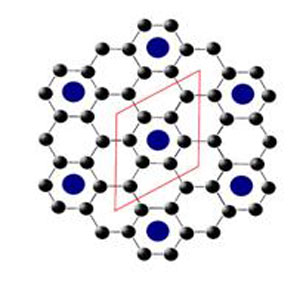| Jan 04, 2012 |
Transforming graphene by potassium doping
|
|
(Nanowerk News) Graphene has been widely touted as a potential replacement for silicon in the next generation of electronic circuits. Before this happens, however, one must fully understand the interaction between the charge carrying electrons and lattice vibrations (phonons) in the material as this interaction sets the ultimate limit of the mobility of the electrons in a material.
|
|
Research undertaken at the London Centre for Nanotechnology has uncovered a dramatic reduction in the graphene phonon lifetimes with high levels of potassium doping (see paper in Physical Review B:"Phonons in potassium-doped graphene: The effects of electron-phonon interactions, dimensionality, and adatom ordering"). The effects are far greater and opposite to those found in the standard electrostatically gated graphene devices and can be explained by a novel, dynamic electron-phonon interaction.
|
 |
| Unit cell of the 2 x 2 potassium (purple atoms) superlattice that forms on graphene (black atoms) at saturation potassium doping.
|
|
Adding potassium atoms is a particularly effective means to dope graphene, as this can transfer especially large densities of electrons to the graphene (up to approximately 10 times that is currently achievable in gated graphene) in a tunable way, transforming the graphene from a 2D semi-metal to a 2D metal. Over 40 years ago a dynamic electron-phonon interaction was predicted to be large in 2D metals with high energy phonons, such as those found in graphene. This means that the normal equilibrium between electrons and phonons dramatically breaks down. This effect can explain the large reduction in phonon lifetimes observed.
|
|
The study also reveals that while at high and low potassium coverage the atoms are evenly distributed, at intermediate levels the potassium atoms surprisingly order into segregated regions of high and low density. In addition, it is demonstrated that 1-4 layer graphene can be tunably highly doped via the addition of potassium atoms but the resulting increase in graphene layer separation isolates the individual graphene layers. Hence the important differences in the electronic structure in the 1-4 layer graphene series are removed by potassium doping, as in all cases the graphene layers are isolated from their neighbouring graphene layers.
|

